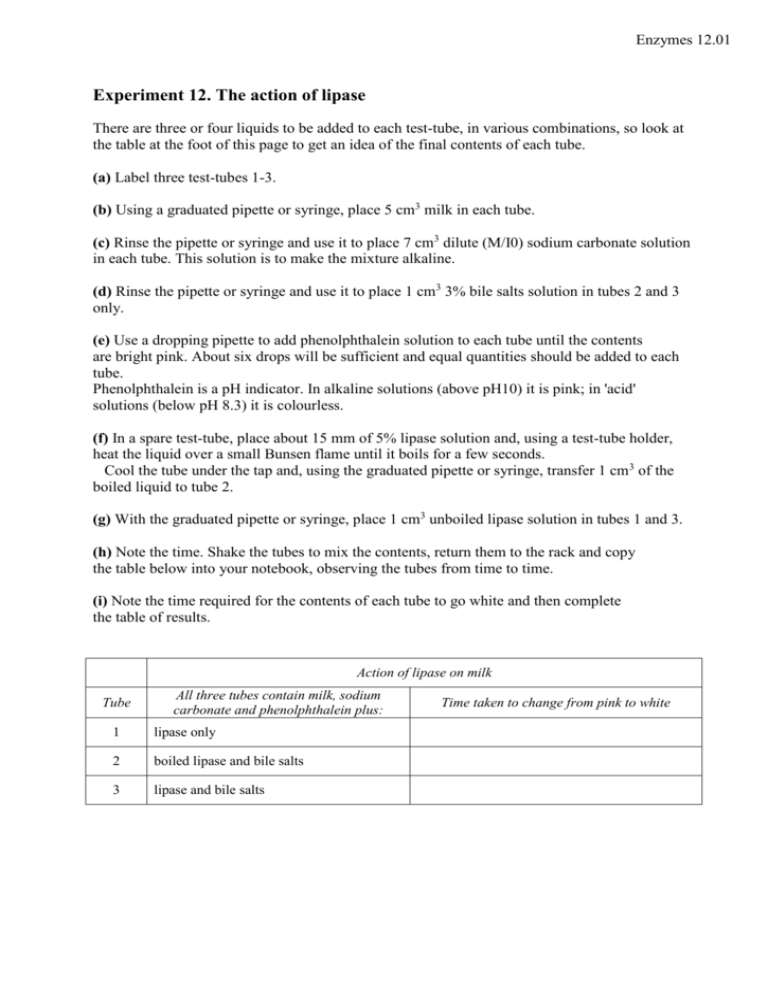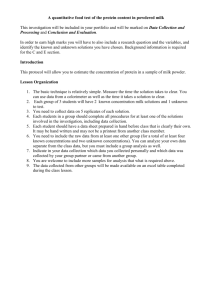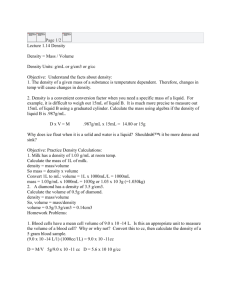12 Action of lipase
advertisement

Enzymes 12.01 Experiment 12. The action of lipase There are three or four liquids to be added to each test-tube, in various combinations, so look at the table at the foot of this page to get an idea of the final contents of each tube. (a) Label three test-tubes 1-3. (b) Using a graduated pipette or syringe, place 5 cm3 milk in each tube. (c) Rinse the pipette or syringe and use it to place 7 cm3 dilute (M/I0) sodium carbonate solution in each tube. This solution is to make the mixture alkaline. (d) Rinse the pipette or syringe and use it to place 1 cm3 3% bile salts solution in tubes 2 and 3 only. (e) Use a dropping pipette to add phenolphthalein solution to each tube until the contents are bright pink. About six drops will be sufficient and equal quantities should be added to each tube. Phenolphthalein is a pH indicator. In alkaline solutions (above pH10) it is pink; in 'acid' solutions (below pH 8.3) it is colourless. (f) In a spare test-tube, place about 15 mm of 5% lipase solution and, using a test-tube holder, heat the liquid over a small Bunsen flame until it boils for a few seconds. Cool the tube under the tap and, using the graduated pipette or syringe, transfer 1 cm3 of the boiled liquid to tube 2. (g) With the graduated pipette or syringe, place 1 cm3 unboiled lipase solution in tubes 1 and 3. (h) Note the time. Shake the tubes to mix the contents, return them to the rack and copy the table below into your notebook, observing the tubes from time to time. (i) Note the time required for the contents of each tube to go white and then complete the table of results. Action of lipase on milk Tube All three tubes contain milk, sodium carbonate and phenolphthalein plus: 1 lipase only 2 boiled lipase and bile salts 3 lipase and bile salts Time taken to change from pink to white Enzymes 12.02 Experiment 12. Discussion 1 What food substances are present in milk? 2 If phenolphthalein changes from pink to colourless, what kind of chemical change must have taken place in the tube? 3 Recall (or look up) the final products of digestion of the principal classes of food and write down which of these products could be formed by the digestion of milk. 4 Which of the final products of digestion of milk could be responsible for the change of conditions in the test-tube? 5 Which part of the experiment suggests that lipase acts as an enzyme? 6 What chemical change could the lipase be producing which would account for the colour change in the test-tubes? 7 Which part of the experiment indicates that bile salts do not contain an enzyme which affects milk (at least in the way being investigated here)? Explain your reasoning. 8 From the results, assuming that lipase is an enzyme, what part do the bile salts appear to be playing in the reaction (in general terms)? 9 Do the results tell you whether lipase is acting on the fat or the protein in milk? Explain. add equal quantities of phenolphthalein to each tube 1 cm3 bile salts 1cm3 lipase solution 5 cm3 milk 7 cm3 sodium carbonate solution 1 cm3 boiled lipase 1 cm3 lipase solution Enzymes 12.03 Experiment 12. The action of lipase - preparation Outline Lipase hydrolyses the fat in milk to fatty acids which react with sodium carbonate to lower the pH of the mixture. This pH change is observed by using phenolphthalein. Prior knowledge The use of indicators to observe pH changes; the final digestion products of proteins, carbohydrates and fats. Advance preparation and materials - per group milk 20 cm3 3% bile salts 10 cm3 [2] 0.05M sodium carbonate 40 cm3 phenolphthalein 5 cm3 [1] 5% lipase solution 10 cm3 [3] Apparatus - per group test-tube rack and 4 test-tubes Bunsen burner 3 labels or spirit marker test-tube holder, dropping pipette beaker or jar (for rinsing pipette or syringe) graduated pipette or syringe 10 cm3 - per class clock Results Tubes 1 and 3 will probably change from pink to white in about 4 minutes. However, since the efficacy of lipase varies, it is advisable to try out the experiment (for tube 3 only) beforehand and, if the reaction is too slow, reduce the volume of sodium carbonate solution or place the tubes in a water bath at 35°C. 1. 1 g dissolved in 200 cm3 ethanol. 2. Available as sodium tauroglycocholate from Philip Harris. 3. Preferably freshly prepared but will keep for a day or two in a refrigerator. It is easier to make a solution (or suspension) of lipase if it is first made into a paste with a little water. Enzymes 12.04 Experiment 12. Discussion - answers 1 Protein (mainly caseinogen), fat (butter fat) and sugar (lactose), are the food substances present in milk. 2 The contents of the tube must have become less alkaline (more acid). 3 Amino acids, fatty acids, glycerol and glucose could be produced by the digestion of milk. 4 Amino acids are amphoteric electrolytes and therefore unlikely to produce the pH changes observed in this experiment. The students are unlikely to know this fact, however, and should consider the production of both amino acids and fatty acids as possible causes of the drop in pH. 5 In tube 2 the lipase is boiled and there is no apparent chemical change when the boiled lipase is added to milk. If lipase is an enzyme, one would expect it to be denatured and rendered inactive above 50 °C 6 The lipase could be converting milk fats into fatty acids and glycerol, or milk protein to amino acids. Either of these changes might be thought to increase the acidity in the test-tubes. 7 If bile salts had an enzyme-like action on milk, one would expect some change to take place in tube 2 where the lipase had been inactivated but the bile salts had not. 8 The bile salts appear to make the reaction go faster. This is not a simple pH effect as shown by tube 2 in which the pH does not change (at least, it is not reduced below pH 8.3). That bile salts are not essential to the reaction is shown by tube 1 in which the milk fat is hydrolysed in the absence of bile salts. 9 In the absence of information about the relative acidity of fatty acids and amino acids (as explained in 4 above) it is not possible to eliminate the latter. However, the faster reaction in the presence of bile salts does suggest fats rather than proteins as the source of the acid.





